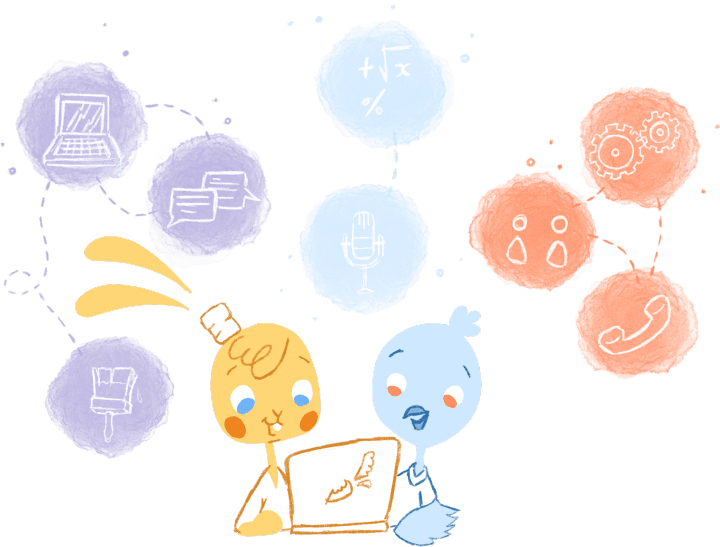

No matter how old you are, take a second and think what your life would be like without technology? While I’m sure that there’s a minority who would welcome this, I think a majority of us would freak out. How could we contact people? How could we entertain or inform ourselves? And, how are we supposed to run our businesses without being connected? But how does technology influence productivity? And, what can you do about it?
Believe it or not, it wasn’t all that long ago that life was like this. Even though complex phone systems, fax machines, and connected computers have been around for decades, it wasn’t until the end of the 20th Century that technology completely reshaped the workplace.
Overall, this was a positive and exciting development. But, there was a cause for concern.
As Phil Kotacka recalls, when email was introduced to this former company in the ’90s, “everyone was working with a 20th-century mentality.” What Kotacka means was that people “lacked the maturity to use this new technology responsibly.”
“Suddenly, employee productivity was shot as people were using e-mail for personal use, sending obscene attachments to the entire corporate mailing list and spreading debilitating viruses of the electronic kind,” continues Kotacka. And, as you can imagine, leaders were cursing this new technology.
Of course, technology is now an essential part of daily life. But, that doesn’t always mean that we treat this great power responsibly.
Instead of focusing on your work, you’re busy scrolling through your social feeds. You and your colleagues embark on lengthy digital conversations that aren’t always work-related. You take precious time out of your day to clean out your inbox. And, like Pavlov’s dog, you instinctively reach for your phone when a notification goes off.
In short, technology has a significant impact on productivity — both good and bad.
How Technology is Increasing Workplace Productivity
There’s no denying that when used correctly, technology can increase workplace productivity. While I’m sure that you’re already well aware of this fact, here is how technology has dramatically improved output:
Brings the team closer together.
No matter when and where you and your team are working, technology has made it possible to collaborate and communicate with each other. You can share and edit documents together. You can exchange ideas or feedback via email, instant messaging, or project management software. And, you can track the progress of each team member.
Technology has made scheduling meetings a breeze. Just share your calendar with your team, and they can see when you’re available to meet, as opposed to playing a game of cat and mouse.
Also, besides saving a ton of time, that’s good for you financially. After all, it’s been found that companies with less than 100 employees lose approximately $420,000 per year due to miscommunication.
Access to information.
Let’s say that you just purchased a new dresser from IKEA. If you’ve ever purchased a piece of furniture from here, then you know that you need instructions. And, in some cases, you’ll also need additional items, like screws and tools. Without these, then there’s no way that you can put together your new purchase.
The same is true when you assign work to your employees. If they don’t have the correct information and tools, then how can you expect them to get the job done? Thankfully, you can easily share this information with them through word documents, spreadsheets, Wikis, or videos.
And, if they do have a problem, they can quickly get in touch with you. They can even take a screenshot to make troubleshooting less as painless as possible.
Automates repetitive tasks.
Gone are the days wasting precious time on trivial, tedious, and repeating tasks. By harnessing the power of automation, you can handle customer service inquiries, schedule social updates, and create automatic office replies.
With artificial intelligence, this will only get better. For example, Calendar uses machine learning to make smart suggestions on when and how to schedule meetings. It will even recommend what type of meeting to plan and who to invite. It can also analyze how you spend your time so that you know how to spend it more productively.
It makes project management seamless.
With project management software like Asana, Basecamp, or Wrike, you can outline projects, assign deadlines, and see where everyone is at. There’s no excuse for anyone to claim that they didn’t start on their part of the project because they were waiting for a colleague to let them know that they were done with their part. The employee can see who is working on what and how far along they are.
Conducive to remote working.
Thanks to technology, remote work has become more commonplace. And, that’s a good thing for the following reasons:
- Those who work remotely are more productive.
- It increases employee retention.
- Remote workers rarely take sick days.
- It reduces costs from employers and employees.
- Remote work increases diversity.
- It can improve mental and physical health.
- Promotes a healthy work-life balance.
- Not only does a majority of people want to work from home, but it’s also become a “standard operating procedure.”
The Darkside of Technology
While technology has improved productivity, it can also have the opposite effect. Mainly, that’s because of the following five reasons:
It’s distracting.
There’s no need to beat around the bush about any subject nowadays. Smartphone notifications, cleaning out your inbox, surfing the net, and talking to others through messaging apps are some of the most common workplace distractions. Considering that Americans check their phones every 12 minutes, it’s a wonder that we get anything done at work.
We’re addicted.
It’s true. Research has found that the constant stimulation we get from our smartphones raises dopamine, which has turned us into bonafide addicts. Social media platforms “leverage the very same neural circuitry used by slot machines and cocaine to keep us using their products as much as possible.”
It’s gotten so bad that “we sometimes feel our phones vibrating in our pockets when they aren’t even there.” I don’t know about you. But, it’s almost impossible for me to be productive when I always believe that I’ve gotten a text or social media notification. That’s because I’ll stop whatever it is that I’m doing and check my phone to make sure.
It’s not good for your physical and mental health.
When you’re not in peak physical and mental health conditions, you can kiss productivity goodbye. After all, it’s difficult to focus when you feel like crap. But that’s exactly what technology is doing to us.
- The way we hold our phones, tablets, and computers is terrible for our posture. As a result, this can lead to neck and back issues. It can also influence our mood and assertiveness.
- Spending too much time on our devices can cause eye strain and headaches. This can also make it difficult to concentrate.
- If you’re on your device too close to bedtime, it can delay your body’s internal clock and circadian rhythm. In turn, this can lead to insomnia.
- Technology is encouraging us to lead a more sedentary lifestyle. As a consequence, this can lead to obesity, diabetes, and cardiovascular disease.
- Social media usage can cause anxiety and depression.
Limits creative thought.
Don’t get me wrong. Having an endless amount of knowledge at your fingertips is incredible. But it also makes us less self-sufficient. Instead of us working through a problem or recalling a piece of information, we search for it online. Some people would go as far as to say that technology is making us dumber.
We’re connecting with technology, not people.
Again. It’s great that you can communicate with anyone in the world whenever you like. But face-to-face communication is still essential.
For starters, it allows you to pick-up on non-verbal cues like body language. It’s also more effective and efficient. Just think about all the times you needed clarification on something. Wasn’t it just faster and more practical to discuss this in-person instead of a lengthy email thread?
And, communicating with others in-person adds that personal touch. It may not sound all that important. But, it allows you to interact and engage with others. In turn, this builds trust and strengthens relationships.
How to Prevent Technology From Inhibiting Productivity
Obviously, we need technology in our professional and personal lives. But, it can also hinder your productivity. Thankfully, there are some easy ways that you can prevent this.
Don’t look at your phone when you first wake-up.
“After turning off your alarm in the morning, take some time before looking at your phone,” recommends Graham Young in a previous Entrepreneur article. “The light from your screen triggers your brain to go into a reactive mode.”
As a result, it “becomes almost a fight-or-flight state.” In other words, your brain has learned “that when the phone is on, potential threats may be coming your way, like emails, text messages, and notifications.”
That’s not the best way to kickstart your day. Instead of focusing on your morning routine, you’re worried about whether or not you received an email response or if anyone liked your social media update.
Turn it off.
I don’t think we need to elaborate too much on this. Turning off your phone when you don’t want to be interrupted is the most effective way to prevent notifications from distracting you. If that causes you too much anxiety, at least put it on an airplane or do not disturb mode.
Block schedule your day.
Definitely block out times for undisturbed work. But, also schedule breaks throughout the day. Ideally, this should be a 17-minute break following 52-minutes of work. If you don’t take a break, then it will be more difficult to resist temptations like checking Facebook or watching a pointless YouTube video.
Additionally, set aside blocks of time to check your email, texts, and any other electronics notifications. If you don’t, you’ll become anxious because of FOMO. To combat this, check your phone during energy, like right before starting work, after lunch, and when you’re wrapping up work for the day.
Impose limits.
I’m not going to lie. For some people, this may seem unimaginable. But, if you follow with the rules and boundaries that you’ve set, eventually, this will become a habit. Even better, this is something that you could do with others. For example, you could designate “tech-free” zones in your home like the dining room. You could also make it a rule that you and your spouse will not look at any electronic devices an hour before bed.
At work, you could implement something like no-email Fridays. Instead, go over and talk to your colleagues in-person. If you have a virtual team, then schedule a call with them. In most cases, however, whatever you need to discuss isn’t an emergency. So, you can wait and send out that email on Monday. Just save the messages as a draft so that you don’t forget.
And, if possible, create a “tech blackout” day at least once a week. For example, on Saturdays, you could completely unplug by spending the entire day outside. If you do need to check your phone, do so sparingly.
Call the productivity police.
Of course, there is no literal productivity police. But, if you’re struggling with time management, then you may want to check out tools like RescueTime, SelfControl, Anti-Social, StayFocusd, or Cold Turkey. They can help you see how you’re spending time on your devices. From there, you can use this data to optimize your time. Better yet, these tools will block distracting websites, apps, and games when you want them to.
Use the 4Ds of time management.
Digitally communicating with others can be a waste of time. Mainly this is because we keep touching each piece of communication more than once. For example, you receive an email. You read it, but then don’t act. You save that for later. Instead, you probably should have just replied or deleted the message when you first interacted with it.
One method to help you with this is the popular 4Ds of time management, which is as follows:
- Delete anything that either doesn’t serve a purpose, or you no longer care about the item.
- Delegate requests to the right party.
- Defer, or delaying, are important messages that you shouldn’t delete. But, that can be addressed when you have time.
- Do is for any messages that take under 2-minutes to respond to.











Albert Costill
My name is Albert Costill and I'm a content marketer at Calendar. If I can help people become more productive in my journey, even better. If you ever have a question about your Calendar or how you can use it - - don't hesitate to reach out. I'm a Calendar Pro.